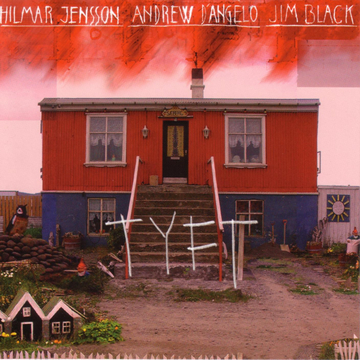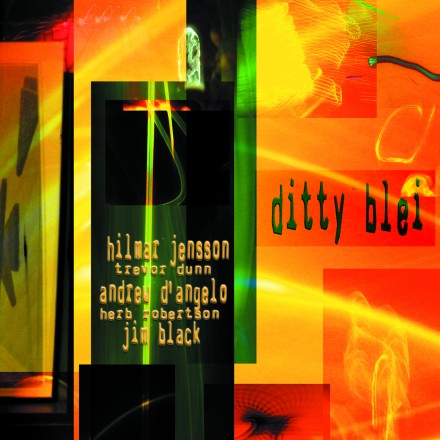Hilmar Jensson
Tyft
SGL 1542-2“…big heavy metal riffs, skronk jazz, funk, electro-fizzle and Ornette Coleman-style disembodied melodies…”
— Jazz Times
Icelandic guitarist Hilmar Jensson formed a new trio with his downtown NY pals, Jim Black and Andrew D’Angelo, for this record of jagged grooves, unpredictable improvs, and live electronic transformations. A provocative atmosphere hovers over the proceedings: nothing goes on for very long, and there are frequent change-ups of tone and style. D’Angelo’s acerbic alto sax and bass clarinet sounds combine with Jensson’s stringent lines and Black’s slashing attack, but equally there are moments of disquieting reverie, and it’s all performed with composure and conviction. Although quite free in part the music is highly organized; if Webern were alive today and into avant-jazz/rock this is the road he might be taking.
Jensson writes: “Even if we have been playing together for over a decade, this is the first time we have performed and recorded just the three of us. We met in Boston in 1990 when Jim and I were attending Berklee and Andrew was working as head of the Jazz department at Tower Records, and together with Chris Speed, Skuli Sverrisson and others developed a close musical bond. More importantly we’ve had a strong friendship since then, and those ties got even stronger when I lived in New York ’93-’94 and the three of us shared a Brooklyn flat together with Chris. Upstairs neighbors were saxist Oscar Noriega and trumpet player Cuong Vu, and our area was filled with musicians like Tim Berne, Mark Dresser, Brad Shepik, Kurt Rosenwinkel, Ben Monder, Jamie Saft and Ben Street, just to name a few. All were frequent visitors to our basement where rehearsals and jams were everyday occurrences. This, together with my collaboration with Skuli during that time and frequently going to hear music at the Knitting Factory and Cooler, has made it the most important period in my early musical growth.
“With Tyft I am sort of revisiting this period, taking the musical ideas that initially brought us together and expanding them. We have all changed immensely as musicians since our early meeting developed our direction, voices and skill; discovered different ideas and musics that have triggered our passions, and of course gained tremendous experience by playing with various projects all over the world. We have found our way to infuse the most important elements of music — passion and conviction — into whatever situations we encounter, and it proved to be very easy on this project, mostly because the trust between us is complete. My intention was to see if we could blend together our composed melodic and rhythmic ideas and our improvisation with the electronic world that we all have a fascination for. Not an uncommon attempt, but I had in mind a unique blend that I had not heard elsewhere. The music is not heavily composed, mainly consisting of melodies and forms that we worked around; many of the compositions finally came together in the editing, when we put together melodies, improvs and electronics that were recorded separately…Tyft is not a word as far as I know. Tyfta is an Icelandic word however and means ‘to put someone in his place’ or even punish someone.”
“An exceptional musician and unique guitarist” (DV, Iceland), Hilmar Jensson was born in Reykjavik in 1966 and graduated from Berklee in 1991. Back in Reykjavik since ’94, he has performed on over 30 records, including four as leader or co-leader (three of them for the Icelandic new music/electronic ambient label Bad Taste, including Kjar, a collaboration with Skuli Sverrisson), and two with Black’s AlasNoAxis. He is one the founders of Kitchen Motors, a genre-busting Icelandic record label, think-tank and art organization, and performs throughout Europe with artists ranging from Portuguese guitarist Rafael Toral to Norwegian trumpeter Arve Henriksen. He has upcoming releases with Sverrisson and Chicago guitarist Kevin Drumm, and has also performed and/or recorded with Leo Smith, Eyvind Kang, Greg Bendian, Terje Isungset, and Joel Palsson.
Jim Black (b. 1967), is widely admired for his work with Tim Berne’s Bloodcount, Dave Douglas (Tiny Bell Trio, SGL 1504), Ellery Eskelin (Jazz Trash, SGL 1506), Chris Speed’s Yeah No (s/t, SGL 1517, Deviantics, SGL 1524, and Emit, SGL 1532), Ben Monder (Flux, SGL 1509), Uri Caine’s Mahler and Bach Projects, Laurie Anderson, the collective Pachora, and his quartet AlasNoAxis (Winter & Winter). He also plays on Hilmar’s 1995 CD Dofinn.
Born in Reykjavik in 1966, Jensson graduated from Berklee College and hung in Boston and Brooklyn with Chris Speed and Jim Black in the early ’90s. He records as leader for Icelandic new music/electronic ambient label Bad Taste, including two collaborations with NY bassist Skuli Sverrisson; has also recorded with Eyvind Kang, Terje Isungset and Jóel Pálsson.
**** “Icelandic guitarist Hilmar Jensson, a present-day Black collaborator who hung with the Human Feel boys during his Berklee days…is emphatically not Kurt Rosenwinkel…[Jensson’s] jagged electric guitar power chords vie for attention with intimate acoustic interludes and experimental noise, sometimes all in the same track. Tyft can be a jittery listen, with Black’s concussive drums and D’Angelo’s alto squeals brashly inserted amidst quieter, even austere segments suggesting an Icelandic take on the ECM school. And since all three musicians here are card-carrying members of the laptop generation, even the tundra jazz portions have a disquieting aspect: Electronic hums, buzzes, rattles, and undefinable sounds intrude upon the calm, as if to suggest that there is nowhere left even to strum an acoustic guitar in peace these days…” — Dave Lynch, Allmusic.com
“…this improvised set is wholly hypnotic and atmospheric, ‘art’ at its most proficient and pointed best. The trio mesh sounds, ideas, patchworks of squeaks and squawks, buzzes, and percussive explosions exquisitely. There are elements of Albert Ayler and Sonny Sharrock in the mix, though Jensson is original and derivations may be hard to pinpoint, particularly in his acoustic work…Excellent. — Mark E. Gallo, Jazzreview.com
“Tyft borrows the energies of [Alasnoaxis] but pares it down, eliminating a bassist and at times the requirement for timekeeping…All three manipulate the music with electronics. They tend to finish each other’s sentences and otherwise read minds. Chirpy sizzles of electronics spread through deconstructed passages, only to end up in melodious endings. Jim Black’s genius is his ability to play the drums as blunt objects, keeping them undiscovered and primitive. Together D’Angelo and Jensson dodge Black in harmonies to maintain balance, only to diverge into an industrial metal on flesh sound.” — Mark Corroto, AllAboutJazz.com
“…an interesting and unusual listen…” — Signal to Noise

